- a region of interstellar dust and gas with a high content of hydrogen gas. The notation H II refers to the fact that the hydrogen atoms (H) are ionized (H I is neutral, un-ionized hydrogen). Within the interstellar cloud are young, hot, blue stars which are emitting large amounts of ultraviolet light ( photons ), which strike the gas and plasma within the nebula and in turn, cause the electrons in the hydrogen nuclei to shift their orbits. When the electrons return to their normal orbit they emit photons at the optical wavelength of of 656.3 nanometers which is that part of the spectrum that is responsible for the
color of these nebula. [1]
- a rotating disk of dust and gas that surrounds the core of a developing solar system. It may eventually develop into orbiting celestial bodies such as planets and asteroids or young newly formed stars like a T Tauri or Herbig star. The protoplanetary disk may be considered an accretion disk because gaseous material may be falling from the inner edge of the disk onto the surface of the star, but this process should not be confused with the accretion process thought to build up the planets themselves. [2]
- a dense core of gas and dust which becomes more and more dense by drawing material into the core. This is called accretion. This process forms accretion disks of which many have been identified with the Hubble Telescope. The core heats up (to about 1500 K) because of the compression, caused by gravity, and begins to shine in the infrared and at radio wavelengths. After about 100,000 years of accretion the protostar has as much mass as the Sun. Eventually, the wind of radiation and particles flowing from the proto-star prevents further material from accreting and it thereafter becomes a pre-main sequence star. [3]
- As a star like our sun is running out of fuel in its core it begins to bloat into a red giant. This will happen to our sun in 5 Billion years. Then after a few million years the outer layers of the red giant will begin to puff off and form a
. Leaving behind only the dead core of the star made of mostly carbon and oxygen. This is the white dwarf. [4]
- below are just a few of the individuals historically or currently associated with nebulae. They include professional or amateur astronomers, scientists, astrophysicists and researchers the world over:
Diffused, Emission Nebula
The Birthplace of Stars
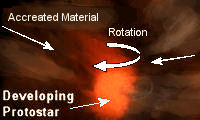
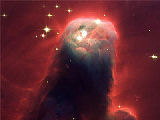
As a ball of dust and gas contracts under its own gravity, it begins to shrink and its core begins collapsing faster and faster. This causes the core to heat up and to rotate. At this stage, the condensed material is called a protostar. One nebula may have many protostars, each of which is destined to be an individual stellar system. When a protostar becomes a self-radiating object, fueled by its own thermonuclear reactions, it becomes a true star. If it's massive enough, a star can ionize the nebular material, producing an area of fluorescence around it. The dark nebula, now glowing, becomes an emission nebula. Seen at right is the Cone Nebula, which is actually just a small portion of a much larger nebular cloud. Image left: Author. Image right:
NASA and STScI
Nebula IC 4954 & IC 4955
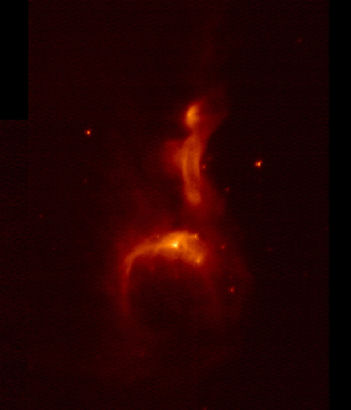
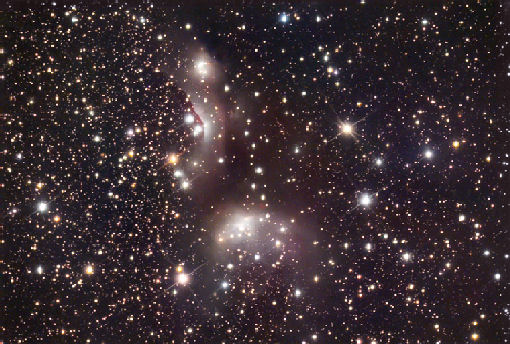
At left is Akari's infrared image of reflection Nebula IC 4954 showing the birth of a star, from the Japan Aerospace Exploration Agency. Notes Prof. Takao Nakagawa of the Institute of Space and Astronautical Science, "Akari clearly captured a moment of a star being born near the reflection nebula IC 4954 [Image left]. This region is about 6,000 light years away from our solar system, and it is believed that new stars have been continually formed over the last several million years. The image shows strong infrared radiation emitted from many spots in the interstellar clouds, which consist of gas and dust, and each spot indicates the birth of a new star. Stars are formed in environments of dense gas and dust. We cannot observe such a location in the visible light, but it is possible in the infrared." [5] At right is another image of Nebula IC 4954 & IC 4955 in the consellation Vulpecula, a constellation created in the late 17th century by the astronomer
Johannes Hevelius. "It was originally known as Vulpecula cum ansere ("the little fox with the goose" or Vulpecula et Anser ("the little fox and the goose"), and was illustrated with a goose in the jaws of a fox. Hevelius did not regard the fox and the goose to be two separate constellations, but later the stars were divided into a separate Anser and Vulpecula. Today, they have been merged again under the name of the fox, but the goose is remembered by the name of the star

Vulpeculae: Anser." [6] Image
(right) credit:
Adam Block/NOAO/AURA/NSF
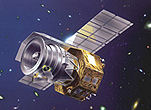
Akari is the Japanese launched ( 2006 ) infrared satellite who's sky surveyor mission, previously known as ASTRO-F or IRIS — InfraRed Imaging Surveyor, is an international effort seeing participation from the Seoul National University as well as UK universities and the ESA. The satellite's missions included a complete survey of the entire infrared sky, a second observing mission of thousands of selected astronomical targets in detail and a third mission in which astronomers from the European consortium have shared observering time. At left is an artist's impression of AKARI, credit:
JAXA. [7]
The Orion Nebula
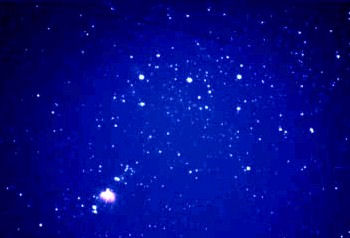
One might think that star formation occurs in the dark and remote corners of our vast universe, but in fact, stars are continually "born" — technically, they form from a process called
gravitational accretion — everwhere in our universe including our own Milkyway galaxy. The birthplace of stars often begins from the remnant of other stars; those that are near the end of their evolutionary life and have gone supernova or from the remains of older stars in the later stages of stellar evolution, Red Giant stars, which have shed their outer surface layers, casting their gas and dust into space via strong stellar winds, creating what we call a Planetary Nebula ( see
Red Giant Stars this site ). Some are large areas of collected gas sand dust, known as a diffused nebula. One such nebula is Orion's, one of the most studied regions of stellar birth and one closest to earth. The Orion Nebula, located in the very prominent constellation often referred to as the hunter, is one of the largest, most conspicuous, and most recognizable in the night sky. It is located approximately 1,500 light-years away, along our spiral arm of the Milky Way, and is visible to the naked eye, resolvable using a pair of binoculars. In the image at right can be seen Orion's belt, the 3 stars along the upper portion, as well as the Orion Nebula, which is seen in lower left side. Image used with the kind permission of
Andrés Valencia from his website
Observatorio ARVAL
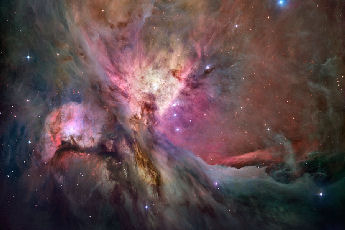
"Few cosmic vistas excite the imagination like the Orion Nebula. Also known as M42, the nebula's glowing gas surrounds hot young stars at the edge of an immense interstellar molecular cloud only 1,500 light-years away. The Orion Nebula offers one of the best opportunities to study how stars are born partly because it is the nearest large star-forming region, but also because the nebula's energetic stars have blown away obscuring gas and dust clouds that would otherwise block our view - providing an intimate look at a range of ongoing stages of starbirth and evolution. This detailed image of the Orion Nebula is the sharpest ever, constructed using data from the Hubble Space Telescope's Advanced Camera for Surveys and the European Southern Observatory's La Silla 2.2 meter telescope. The mosaic contains a billion pixels at full resolution and reveals about 3,000 stars." Image & credit:
APOD NASA, ESA, M. Robberto (STScI/ESA) et al. Clicking on the image will take you to the APOD website where the full resolution image is located.
Astronomers, recently completing one of the most wide-ranging surveys of baby stars in and around the Orion nebula found a stellar nursery that has been labelled both "chaotic" and "crowded", says the SPACE.com website. Regarding the survey, the article,
Census Finds Unknown Young Stars of Orion, notes that:
'The work represents the first complete study of young stars, their gaseous clouds of dust and supersonic jets of hydrogen molecules shooting out from the poles of each star. "With such a large number of young stars, we can study the 'demographics' of star birth," said Tom Megeath, an astronomer at the University of Toledo in Ohio. "This study will give us an idea of how long it takes baby stars to bulk up by pulling in gas from the surrounding cloud, what ultimately stops a star from growing bigger, and how a star's birth is influenced by other stars in the stellar nursery."' [8] The "jets" mentioned in the article refer to
Herbig-Haro objects, also dicussed at this site in a recent publication regarding these stellar objects and which have also seen numerous research and survey work, see
M. Rosado et al. for example.
Reflections on a Nebula
From the Pleiades to IC 2118

"In Astronomy, reflection nebulae are clouds of dust which are simply reflecting the light of a nearby star or stars. The energy from the nearby star, or stars, is insufficient to ionize the gas of the nebula to create an emission nebula, but is enough to give sufficient scattering to make the dust visible. Thus, the frequency spectrum shown by reflection nebulae is similar to that of the illuminating stars...Reflection nebulae are usually blue because the scattering is more efficient for blue light than red (this is the same scattering process that gives us blue skies and red sunsets)." from
Wikipedia This open cluster of stars is located at RA 03 47.4 Dec +24 07. Image at right of M45 from
Astronomia Bajo Las Nubes, by Antonio Fernandez-Sanchez, and used with the kind permission of
Antonio Fernandez. It may also be viewed at a higher resolution at the
APOD web site.
The Pleiades star cluster is both a prominent and common sight in winter, in the Northern Hemisphere and in summer, in the Southern Hemisphere, and has been known since antiquity to cultures all around the world. The Pleiades (
Peleiades ), their name meaning a "flock of doves" or "constellation of the doves" depending on the line of mythology followed, is consistent with the sisters' mythological transformation. The star cluster, also known as M45, consists ( for the stars known as the Seven Sisters ) of Alcyone, Asterope, Celæno, Electra, Maia, Merope and Taygeta ( Taygete ) [9].
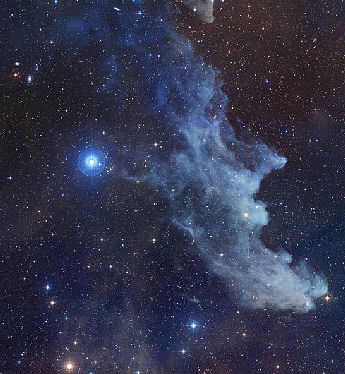
Another blue reflection nebula is the "Witch Head" or
IC 2118, which "is believed to be an ancient supernova remnant or gas cloud. It is illuminated by the nearby supergiant star
Rigel in Orion ( off the image , right of the "nose" ). It lies in the Eridanus constellation, about 1000 light-years from Earth. The nature of the dust particles, reflecting blue light better than red, is a factor in giving the Witch Head its blue color." —
Wikipedia. Image left: data from the
Digitized Sky Survey with color composite work by
Noel Carboni.
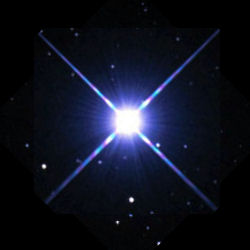
At right is the star Rigel. Writing for
Space.com, Pedro Braganca notes, "On the western heel of Orion, the Hunter, rests brilliant Rigel. In classical mythology, Rigel marks the spot where Scorpio, the Scorpion stung Orion after a brief and fierce battle. Its Arabic name means the Foot.
Rigel is a multiple star system. The brighter component, Rigel A, is a blue super giant that shines a remarkable 40,000 times stronger than the Sun! Although 775 light-years distant, its light shines bright in our evening skies, at magnitude 0.12." [10]
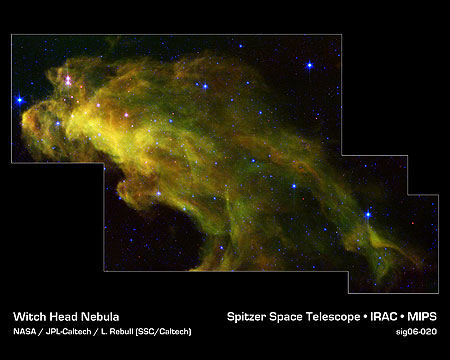
The Witch Head Nebula was also targeted as part of the Spitzer Space Telescope Research Program for Teachers and Students, involving high school teachers and their students from across the United States. "The stellar infants are revealed as pink dots in this image from NASA's Spitzer Space Telescope. Wisps of green in the cloud are carbon-rich molecules called polycyclic aromatic hydrocarbons, which are found on barbecue grills and in automobile exhaust on Earth...The infrared image is a three-color composite, in which light with a wavelength of 4.5 microns is blue, 8.0-micron light is green, and 24-micron light is red." — from the
Spitzer Science Center, California Institute of Technology [11]
This stellar region has seen similar survey work in the past, with previous studies suggesting "that star formation was triggered in the IC 2118 clouds by shock waves originating from Orion OB 1, and thus this group of young low-mass stars is a distinct subsystem of the Orion star forming region." (
M. Kun et al., 2004 &
2001 )

Unlike the morphology of other nebulae, the Trifid Nebula ( Messier 20, M20 or NGC 6514 ) is a unique Hydrogen II region located in Sagittarius. We say
unique because it is an "unusual combination of an open cluster of stars, an emission nebula (the lower, red portion), a reflection nebula (the upper, blue portion) and a dark nebula (the apparent 'gaps' within the emission nebula that cause the trifid appearance; these are also designated Barnard 85). Viewed through a small telescope, the Trifid Nebula is a bright and colorful object, and is thus a perennial favorite of amateur astronomers."
Wikipedia. The Nebula lies within our Milky Way galaxy, about 9,000 light-years from Earth and has seen several revealing surveys into it's star forming regions, as will be featured later on in this section on nebulae. Discovered by Charles Messier on June 5, 1764, the name "Trifid" was actually coined by astronomer
John Herschel because of the dark lanes he observed that divided the glowing nebula into three pieces ( as he saw them, though there are four ). Close up images of the Trifid's central emission/reflection regions can be viewed at the APOD web site:
M20: The Trifid Nebula —
The Trifid Nebula in Red, White and Blue —
A Beautiful Trifid
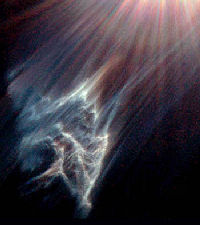

At left, a nebula in the Pleiades — Reflection (
Diffused ) Nebula IC 349, from
STScI Hubble Space Telescope. "In 1890, American astronomer E. E. Barnard, observing visually with the Lick Observatory 36-inch telescope in California, discovered an exceptionally bright nebulosity adjacent to the bright
Pleiades star Merope. It is now cataloged as IC 349, or "Barnard's Merope Nebula." IC 349 is so bright because it lies extremely close to Merope -- only about 3,500 times the separation of the Earth from the Sun, or about 0.06 light-year -- and thus is strongly illuminated by the star's light." [12] At right is reflection nebula
NGC 1999, "The nebula is illuminated by a bright, recently formed star, visible just to the left of center. This star is cataloged as V380 Orionis, and its white color is due to its high surface temperature of about 10,000 degrees Celsius, nearly twice that of our own sun. Its mass is estimated to be 3.5 times that of the sun. The star is so young that it is still surrounded by a cloud of material left over from its formation, here seen as the NGC 1999 reflection nebula." Image credit:
NASA and The Hubble Heritage Team (STScI) This image was taken several weeks after the December 1999 Hubble Space Telescope Servicing Mission 3A (STS-103).
4. Planetary Nebula
From a Universe of Beauty
Stars that Shape Forms
NGC 3132, the "Eight-Burst" or "Southern Ring" Planetary Nebula
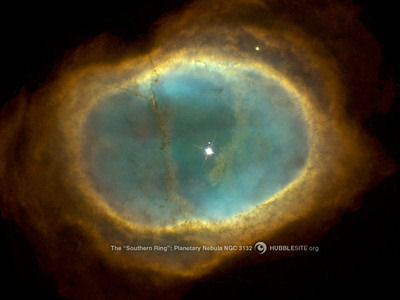
"A planetary nebula is an emission nebula consisting of a glowing shell of gas and plasma formed by certain types of stars when they die. The name originated in the 18th century because of their similarity in appearance to giant planets when viewed through small optical telescopes, and is unrelated to the planets of the solar system. They are a relatively short-lived phenomenon, lasting a few tens of thousands of years, compared to a typical stellar lifetime of several billion years." —
Wikipedia

In their news release on NGC 3132, the Hubble Heritage Team said, "This image, captured by NASA's Hubble Space Telescope, clearly shows two stars near the center of the nebula, a bright white one, and an adjacent, fainter companion to its upper right. (A third, unrelated star lies near the edge of the nebula.) The faint partner [
arrow ] is actually the star that has ejected the nebula. This star is now smaller than our own Sun, but extremely hot. The flood of ultraviolet radiation from its surface makes the surrounding gases glow through fluorescence. The brighter star is in an earlier stage of stellar evolution, but in the future it will probably eject its own planetary nebula." Credit:
Hubble Heritage Team (STScI/AURA/NASA)
The Helix Planetary Nebula

"Will our Sun look like this one day? The Helix Nebula is one of brightest and closest examples of a planetary nebula, a gas cloud created at the end of the life of a Sun-like star. The outer gasses of the star expelled into space appear from our vantage point as if we are looking down a helix. The remnant central stellar core, destined to become a white dwarf star, glows in light so energetic it causes the previously expelled gas to fluoresce. The Helix Nebula, given a technical designation of NGC 7293, lies about 700 light-years away towards the constellation of Aquarius and spans about 2.5 light-years. The above picture was taken by the Wide Field Imager on the 2.2-meter Telescope at the European Southern Observatory's La Silla Observatory. A close-up of the inner edge of the Helix Nebula shows complex gas knots of unknown origin." Credit: WFI, MPG/ESO 2.2-m Telescope, La Silla Obs., ESO -- Image as seen at
APOD As reported at this site (
The Helix Nebula ) this image has, since it's publication, been referred to under the title "The Eye of God", a name for which it was never given by NASA but is still in use —
see here. Also see:
Urban Legends website
Planetary Nebula Kohoutek 4-55
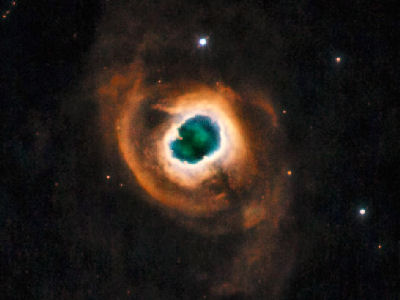
Saying goodbye this year to one of the most successful and longest running stellar CCD imaging cameras ever, the Hubble Space Telescope's
Wide Field Planetary Camera 2, the space's telescope's mission team of NASA, ESA, the Hubble Heritage Team (STScI/AURA), Dr. Raghvendra Sahai and Dr. John Trauger ( NASA/Jet Propulsion Laboratory ) took the image at left of Kohoutek 4-55 on May 4, 2009. "This planetary nebula is known as Kohoutek 4-55 (or K 4-55). It is one of a series of planetary nebulae that were named after their discoverer, Czech astronomer
Lubos Kohoutek. A planetary nebula contains the outer layers of a red giant star that were expelled into interstellar space when the star was in the late stages of its life. Ultraviolet radiation emitted from the remaining hot core of the star ionizes the ejected gas shells, causing them to glow." From the NASA image of the day article,
Pretty as a Picture. As previously noted, the name
Planetary Nebula is a bit of a misnomer since these objects have naught to do with planets but rather stars, "
William Herschel eventually invented the name "Planetary Nebula" for these objects in his classification of nebulae in 1784 or 1785, because he found them to resemble the planet newly discovered by him, Uranus. On November 13, 1790, Herschel found the planetary nebula NGC 1514 (his H IV.69), which has a very bright central star; thus he became convinced that the planetary nebulae were nebulous material (gas or dust) associated with a central star, and not unresolved clusters as he and others had thought previously." From the SEDS website article,
Planetary Nebulae.
The Planetary Nebula NGC 6543
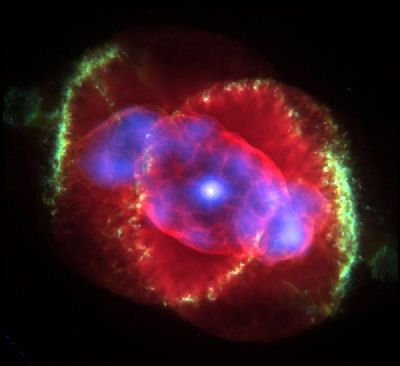
Since there is certainly no lack of images from science, professional or amateur astronomers world wide, finding one or two that top the list as "best" might be a rather difficult call as almost all look "just too cool". However, one of the earliest APOD images from NASA and the Hubble Space Telescope appeared June 28, 1995, under the title
Cat's Eye Nebula; one that caught this author's attention and launched this web site. At right and similar to that original image is a composite photo, made using optical images from the
Hubble Space Telescope and X-ray data from the
Chandra X-ray Observatory. This particular image, says the Chandra site, "offers astronomers an opportunity to compare where the hotter, X-ray emitting gas appears in relation to the cooler material seen in optical wavelengths. The Chandra team found that the chemical abundances in the region of hot gas (its X-ray intensity is shown in purple) were like those in the wind from the central star and different from the outer cooler material (the red and green structures.)" The nebula is located at RA 17 58 33.30 Dec +66 37 59.20 in the constellation
Draco. This particular image presented scientists with a puzzle as the X-ray emitted material ( purple indicating it's intensity ) was expected to be much hotter than indicated, leading them to conclude that another process was at work "mixing" and cooling the X-ray emitted material. It is, like the Helix nebula above, one of the most complex nebulae known, and one, containing remarkable structures such as knots, jets and arc-like features. Credit: Chandra X-ray Observatory website
Chandra Reveals The X-Ray Glint In The Cat's Eye ( Also see The Astrophysical Journal,
You-Hua Chu et al., 2001 )
Cat's Eye Redux
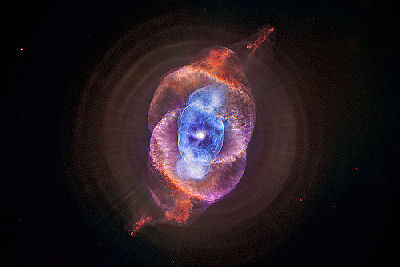
At left is a second composite image of the Cat's Eye Nebula from the
Chandra's X-ray website. It shows x-ray data (colored in blue) and the nebula's central star which is surrounded by a cloud of multi-million-degree gas. "By comparing where the X-rays lie in relation to the structures seen in optical light by Hubble (red and purple), astronomers were able to deduce that the chemical abundances in the region of hot gas were like those in the wind from the central star and different from the outer cooler material. In the case of the Cat's Eye, material shed by the star is flying away at a speed of about 4 million miles per hour. The star itself is expected to collapse to become a white dwarf star in a few million years." Credit: X-ray: NASA/CXC/SAO; Optical: NASA/STScI. It is to the complex morphology of planetary nebulae, like the Cat's Eye, that research scientists like Richard A. Shaw of the National Optical Astronomy Observatory say is key to understanding many of the outstanding questions regarding nebula of this type. "Planetary nebulae (PNe) are produced by post-Asympotic Giant Branch stars, whose progenitors span a mass range of about 1—8 M

This relatively brief phase of stellar evolution involves rapid evolution of the central star to very high temperatures, followed by a decline in luminosity as the star approaches white dwarf dimensions. While much is known about PNe, there are a number of fairly profound (and in some cases, simple) questions that remain unanswered: How many PNe are there in the Galaxy? What fraction of sub-supernova stars produce detectible PNe? What forces produce the complex (and beautiful!) morphologies seen in PNe? How many PNe are produced by stars in binary systems?"
Richard A. Shaw scientist at the National Optical Astronomy Observatory

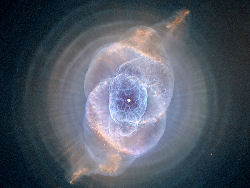
At left, the Cat's Eye nebula is both weird and beautiful "[i]ts haunting symmetries are seen in the very central region of this stunning false-color picture, processed to reveal the enormous but extremely faint halo of gaseous material, over three light-years across, which surrounds the brighter, familiar planetary nebula. Made with data from the Nordic Optical Telescope in the Canary Islands, the composite picture shows emission from nitrogen atoms as red and oxygen atoms as green and blue shades." Credit: R. Corradi
(Isaac Newton Group),
D. Goncalves (Inst. Astrofisica de Canarias) At right is our final image of NGC 6543 from the
APOD website, where the editor's write: "Staring across interstellar space, the alluring Cat's Eye nebula lies three thousand light-years from Earth. A classic planetary nebula, the Cat's Eye (NGC 6543) represents a final, brief yet glorious phase in the life of a sun-like star. This nebula's dying central star may have produced the simple, outer pattern of dusty concentric shells by shrugging off outer layers in a series of regular convulsions. But the formation of the beautiful, more complex inner structures is not well understood. Seen so clearly in this sharp Hubble Space Telescope image, the truly cosmic eye is over half a light-year across. Of course, gazing into the Cat's Eye, astronomers may well be seeing the fate of our sun, destined to enter its own planetary nebula phase of evolution ... in about 5 billion years." Credit: NASA, ESA, HEIC, and The Hubble Heritage Team (STScI/AURA)
Every student who enters upon a scientific pursuit, especially if at a somewhat advanced period of life, will find not only that he has much to learn, but much also to unlearn. — Sir John Herschel, Outlines of Astronomy (1871), 11th edn., 1
Very Heartfelt Thank You's
First, as editing and posting these pages occur within a period of just days, I am always amazed at how fast I receive responses to requests for permission to use the material of others. As such, a very special Thank You is due to Andrés Valencia and Antonio Fernandez, both of whom responded very expeditiously to my inquiries.
In addition to the numerous links that appear on the pages of this website, there is also a wealth of astronomical data from all psossible sources across the world wide web and this list of sources is quite extensive. For those wishing a complete listing for any of the catagories under discussion, such a file will be made available after the completion and posting of the entire topic.
To the websites that I frequently use herein, I would like to recognize and thank the individuals who make possible the material that is available to everyone, everwhere, in the pursuit of knowledge and in the furtherance of education. They include but are certainly not limited to: NASA/IPAC Extragalactic Database ( NED ) which is operated by the Jet Propulsion Laboratory, California Institute of Technology, under contract with NASA, the Simbad Data Query & Aladin Sky Atlas websites, the HEASARC Data Archive, the Astronomy Picture of the Day website, the ESO, the Spitzer Space Telescope website, the Chandra X-Ray Observatory website, the Sloan Digital Sky Survey website, the Anglo-Australian Observatory website, the European homepage for the NASA/ESA Hubble Space Telescope, the Pulkova Observatory Saint Petersburg Russia website, the Astronomical Journal website and the NASA/JPL website.
Return to the Top

 Diffused Nebulae, like the Omega Nebula left, are illuminated nebulae that are extended, containing no well-defined boundaries. These nebulae are usually classified into Emission and Reflection types. Emission Nebulae, like NGC 2174 at right, are internally illuminated clouds of ionized gas. Two of the most common types of emission nebula are H II Regions and Planetary Nebulae.
Diffused Nebulae, like the Omega Nebula left, are illuminated nebulae that are extended, containing no well-defined boundaries. These nebulae are usually classified into Emission and Reflection types. Emission Nebulae, like NGC 2174 at right, are internally illuminated clouds of ionized gas. Two of the most common types of emission nebula are H II Regions and Planetary Nebulae.
 Reflection Nebulae are illuminated as a result of light reflection from nearby stars. An example is the nebulosity surrounding the Pleiades star cluster, seen at left and known as NGC 1435. Planetary Nebulae, like PN Mz3 at right, are compact shells of gas around a dead star or an intermittantly active star. They form as a result of a star's outer layers being expelled via pulsations or strong stellar winds.
Reflection Nebulae are illuminated as a result of light reflection from nearby stars. An example is the nebulosity surrounding the Pleiades star cluster, seen at left and known as NGC 1435. Planetary Nebulae, like PN Mz3 at right, are compact shells of gas around a dead star or an intermittantly active star. They form as a result of a star's outer layers being expelled via pulsations or strong stellar winds.
 Supernova Remnants like Cas A at left result from the massive and cataclysmic detonation of a star. The resulting debris from the blast, the star's remnants, move away at high speed and are heated by colliding with (relatively) slow moving dust and gas. Dark or Absorption Nebulae, like LDN 1622 at right, are unilluminated. They can be detected only when they obscure stars or other nebulae. Famous examples include the Horsehead nebula in Orion, and the Coalsack Nebula in the Southern Cross.
Supernova Remnants like Cas A at left result from the massive and cataclysmic detonation of a star. The resulting debris from the blast, the star's remnants, move away at high speed and are heated by colliding with (relatively) slow moving dust and gas. Dark or Absorption Nebulae, like LDN 1622 at right, are unilluminated. They can be detected only when they obscure stars or other nebulae. Famous examples include the Horsehead nebula in Orion, and the Coalsack Nebula in the Southern Cross.
 Protoplanetary Nebulae like Gomez's Hamburger at left, form during a star's rapid stellar evolution between the late asymptotic giant branch (LAGB) phase and the subsequent planetary nebula (PN) phase. However, the name "protoplanetary" may be a slight misnomer. Another name suggested for this type of nebula, "Preplanetary Nebula" has been suggested by Sahai, Sánchez Contreras & Morris 2005, fn.1 as it does not overlap with any other disciplines of astronomy. Image left of IRAS 19024+0044 from Sahai et al. The Astrophysical Journal, 620:948—960, 2005 February 20
Protoplanetary Nebulae like Gomez's Hamburger at left, form during a star's rapid stellar evolution between the late asymptotic giant branch (LAGB) phase and the subsequent planetary nebula (PN) phase. However, the name "protoplanetary" may be a slight misnomer. Another name suggested for this type of nebula, "Preplanetary Nebula" has been suggested by Sahai, Sánchez Contreras & Morris 2005, fn.1 as it does not overlap with any other disciplines of astronomy. Image left of IRAS 19024+0044 from Sahai et al. The Astrophysical Journal, 620:948—960, 2005 February 20 Johannes Hevelius
Johannes Hevelius  John Herschel
John Herschel  William Herschel
William Herschel  E. E. Barnard
E. E. Barnard Richard A. Shaw
Richard A. Shaw  Lubos Kohoutek
Lubos Kohoutek  William Huggins
William Huggins  Charles Messier
Charles Messier Williamina P. Fleming
Williamina P. Fleming









 As a ball of dust and gas contracts under its own gravity, it begins to shrink and its core begins collapsing faster and faster. This causes the core to heat up and to rotate. At this stage, the condensed material is called a protostar. One nebula may have many protostars, each of which is destined to be an individual stellar system. When a protostar becomes a self-radiating object, fueled by its own thermonuclear reactions, it becomes a true star. If it's massive enough, a star can ionize the nebular material, producing an area of fluorescence around it. The dark nebula, now glowing, becomes an emission nebula. Seen at right is the Cone Nebula, which is actually just a small portion of a much larger nebular cloud. Image left: Author. Image right:
As a ball of dust and gas contracts under its own gravity, it begins to shrink and its core begins collapsing faster and faster. This causes the core to heat up and to rotate. At this stage, the condensed material is called a protostar. One nebula may have many protostars, each of which is destined to be an individual stellar system. When a protostar becomes a self-radiating object, fueled by its own thermonuclear reactions, it becomes a true star. If it's massive enough, a star can ionize the nebular material, producing an area of fluorescence around it. The dark nebula, now glowing, becomes an emission nebula. Seen at right is the Cone Nebula, which is actually just a small portion of a much larger nebular cloud. Image left: Author. Image right: 
 At left is Akari's infrared image of reflection Nebula IC 4954 showing the birth of a star, from the Japan Aerospace Exploration Agency. Notes Prof. Takao Nakagawa of the Institute of Space and Astronautical Science, "Akari clearly captured a moment of a star being born near the reflection nebula IC 4954 [Image left]. This region is about 6,000 light years away from our solar system, and it is believed that new stars have been continually formed over the last several million years. The image shows strong infrared radiation emitted from many spots in the interstellar clouds, which consist of gas and dust, and each spot indicates the birth of a new star. Stars are formed in environments of dense gas and dust. We cannot observe such a location in the visible light, but it is possible in the infrared." [5] At right is another image of Nebula IC 4954 & IC 4955 in the consellation Vulpecula, a constellation created in the late 17th century by the astronomer
At left is Akari's infrared image of reflection Nebula IC 4954 showing the birth of a star, from the Japan Aerospace Exploration Agency. Notes Prof. Takao Nakagawa of the Institute of Space and Astronautical Science, "Akari clearly captured a moment of a star being born near the reflection nebula IC 4954 [Image left]. This region is about 6,000 light years away from our solar system, and it is believed that new stars have been continually formed over the last several million years. The image shows strong infrared radiation emitted from many spots in the interstellar clouds, which consist of gas and dust, and each spot indicates the birth of a new star. Stars are formed in environments of dense gas and dust. We cannot observe such a location in the visible light, but it is possible in the infrared." [5] At right is another image of Nebula IC 4954 & IC 4955 in the consellation Vulpecula, a constellation created in the late 17th century by the astronomer  Vulpeculae: Anser." [6] Image (right) credit:
Vulpeculae: Anser." [6] Image (right) credit:  Akari is the Japanese launched ( 2006 ) infrared satellite who's sky surveyor mission, previously known as ASTRO-F or IRIS — InfraRed Imaging Surveyor, is an international effort seeing participation from the Seoul National University as well as UK universities and the ESA. The satellite's missions included a complete survey of the entire infrared sky, a second observing mission of thousands of selected astronomical targets in detail and a third mission in which astronomers from the European consortium have shared observering time. At left is an artist's impression of AKARI, credit:
Akari is the Japanese launched ( 2006 ) infrared satellite who's sky surveyor mission, previously known as ASTRO-F or IRIS — InfraRed Imaging Surveyor, is an international effort seeing participation from the Seoul National University as well as UK universities and the ESA. The satellite's missions included a complete survey of the entire infrared sky, a second observing mission of thousands of selected astronomical targets in detail and a third mission in which astronomers from the European consortium have shared observering time. At left is an artist's impression of AKARI, credit:  One might think that star formation occurs in the dark and remote corners of our vast universe, but in fact, stars are continually "born" — technically, they form from a process called
One might think that star formation occurs in the dark and remote corners of our vast universe, but in fact, stars are continually "born" — technically, they form from a process called 
 "In Astronomy, reflection nebulae are clouds of dust which are simply reflecting the light of a nearby star or stars. The energy from the nearby star, or stars, is insufficient to ionize the gas of the nebula to create an emission nebula, but is enough to give sufficient scattering to make the dust visible. Thus, the frequency spectrum shown by reflection nebulae is similar to that of the illuminating stars...Reflection nebulae are usually blue because the scattering is more efficient for blue light than red (this is the same scattering process that gives us blue skies and red sunsets)." from
"In Astronomy, reflection nebulae are clouds of dust which are simply reflecting the light of a nearby star or stars. The energy from the nearby star, or stars, is insufficient to ionize the gas of the nebula to create an emission nebula, but is enough to give sufficient scattering to make the dust visible. Thus, the frequency spectrum shown by reflection nebulae is similar to that of the illuminating stars...Reflection nebulae are usually blue because the scattering is more efficient for blue light than red (this is the same scattering process that gives us blue skies and red sunsets)." from  Another blue reflection nebula is the "Witch Head" or
Another blue reflection nebula is the "Witch Head" or  At right is the star Rigel. Writing for
At right is the star Rigel. Writing for  The Witch Head Nebula was also targeted as part of the Spitzer Space Telescope Research Program for Teachers and Students, involving high school teachers and their students from across the United States. "The stellar infants are revealed as pink dots in this image from NASA's Spitzer Space Telescope. Wisps of green in the cloud are carbon-rich molecules called polycyclic aromatic hydrocarbons, which are found on barbecue grills and in automobile exhaust on Earth...The infrared image is a three-color composite, in which light with a wavelength of 4.5 microns is blue, 8.0-micron light is green, and 24-micron light is red." — from the
The Witch Head Nebula was also targeted as part of the Spitzer Space Telescope Research Program for Teachers and Students, involving high school teachers and their students from across the United States. "The stellar infants are revealed as pink dots in this image from NASA's Spitzer Space Telescope. Wisps of green in the cloud are carbon-rich molecules called polycyclic aromatic hydrocarbons, which are found on barbecue grills and in automobile exhaust on Earth...The infrared image is a three-color composite, in which light with a wavelength of 4.5 microns is blue, 8.0-micron light is green, and 24-micron light is red." — from the  Unlike the morphology of other nebulae, the Trifid Nebula ( Messier 20, M20 or NGC 6514 ) is a unique Hydrogen II region located in Sagittarius. We say unique because it is an "unusual combination of an open cluster of stars, an emission nebula (the lower, red portion), a reflection nebula (the upper, blue portion) and a dark nebula (the apparent 'gaps' within the emission nebula that cause the trifid appearance; these are also designated Barnard 85). Viewed through a small telescope, the Trifid Nebula is a bright and colorful object, and is thus a perennial favorite of amateur astronomers."
Unlike the morphology of other nebulae, the Trifid Nebula ( Messier 20, M20 or NGC 6514 ) is a unique Hydrogen II region located in Sagittarius. We say unique because it is an "unusual combination of an open cluster of stars, an emission nebula (the lower, red portion), a reflection nebula (the upper, blue portion) and a dark nebula (the apparent 'gaps' within the emission nebula that cause the trifid appearance; these are also designated Barnard 85). Viewed through a small telescope, the Trifid Nebula is a bright and colorful object, and is thus a perennial favorite of amateur astronomers." 
 At left, a nebula in the Pleiades — Reflection ( Diffused ) Nebula IC 349, from
At left, a nebula in the Pleiades — Reflection ( Diffused ) Nebula IC 349, from  "A planetary nebula is an emission nebula consisting of a glowing shell of gas and plasma formed by certain types of stars when they die. The name originated in the 18th century because of their similarity in appearance to giant planets when viewed through small optical telescopes, and is unrelated to the planets of the solar system. They are a relatively short-lived phenomenon, lasting a few tens of thousands of years, compared to a typical stellar lifetime of several billion years." —
"A planetary nebula is an emission nebula consisting of a glowing shell of gas and plasma formed by certain types of stars when they die. The name originated in the 18th century because of their similarity in appearance to giant planets when viewed through small optical telescopes, and is unrelated to the planets of the solar system. They are a relatively short-lived phenomenon, lasting a few tens of thousands of years, compared to a typical stellar lifetime of several billion years." —  In their news release on NGC 3132, the Hubble Heritage Team said, "This image, captured by NASA's Hubble Space Telescope, clearly shows two stars near the center of the nebula, a bright white one, and an adjacent, fainter companion to its upper right. (A third, unrelated star lies near the edge of the nebula.) The faint partner [ arrow ] is actually the star that has ejected the nebula. This star is now smaller than our own Sun, but extremely hot. The flood of ultraviolet radiation from its surface makes the surrounding gases glow through fluorescence. The brighter star is in an earlier stage of stellar evolution, but in the future it will probably eject its own planetary nebula." Credit:
In their news release on NGC 3132, the Hubble Heritage Team said, "This image, captured by NASA's Hubble Space Telescope, clearly shows two stars near the center of the nebula, a bright white one, and an adjacent, fainter companion to its upper right. (A third, unrelated star lies near the edge of the nebula.) The faint partner [ arrow ] is actually the star that has ejected the nebula. This star is now smaller than our own Sun, but extremely hot. The flood of ultraviolet radiation from its surface makes the surrounding gases glow through fluorescence. The brighter star is in an earlier stage of stellar evolution, but in the future it will probably eject its own planetary nebula." Credit:  "Will our Sun look like this one day? The Helix Nebula is one of brightest and closest examples of a planetary nebula, a gas cloud created at the end of the life of a Sun-like star. The outer gasses of the star expelled into space appear from our vantage point as if we are looking down a helix. The remnant central stellar core, destined to become a white dwarf star, glows in light so energetic it causes the previously expelled gas to fluoresce. The Helix Nebula, given a technical designation of NGC 7293, lies about 700 light-years away towards the constellation of Aquarius and spans about 2.5 light-years. The above picture was taken by the Wide Field Imager on the 2.2-meter Telescope at the European Southern Observatory's La Silla Observatory. A close-up of the inner edge of the Helix Nebula shows complex gas knots of unknown origin." Credit: WFI, MPG/ESO 2.2-m Telescope, La Silla Obs., ESO -- Image as seen at
"Will our Sun look like this one day? The Helix Nebula is one of brightest and closest examples of a planetary nebula, a gas cloud created at the end of the life of a Sun-like star. The outer gasses of the star expelled into space appear from our vantage point as if we are looking down a helix. The remnant central stellar core, destined to become a white dwarf star, glows in light so energetic it causes the previously expelled gas to fluoresce. The Helix Nebula, given a technical designation of NGC 7293, lies about 700 light-years away towards the constellation of Aquarius and spans about 2.5 light-years. The above picture was taken by the Wide Field Imager on the 2.2-meter Telescope at the European Southern Observatory's La Silla Observatory. A close-up of the inner edge of the Helix Nebula shows complex gas knots of unknown origin." Credit: WFI, MPG/ESO 2.2-m Telescope, La Silla Obs., ESO -- Image as seen at  Saying goodbye this year to one of the most successful and longest running stellar CCD imaging cameras ever, the Hubble Space Telescope's
Saying goodbye this year to one of the most successful and longest running stellar CCD imaging cameras ever, the Hubble Space Telescope's  Since there is certainly no lack of images from science, professional or amateur astronomers world wide, finding one or two that top the list as "best" might be a rather difficult call as almost all look "just too cool". However, one of the earliest APOD images from NASA and the Hubble Space Telescope appeared June 28, 1995, under the title
Since there is certainly no lack of images from science, professional or amateur astronomers world wide, finding one or two that top the list as "best" might be a rather difficult call as almost all look "just too cool". However, one of the earliest APOD images from NASA and the Hubble Space Telescope appeared June 28, 1995, under the title  At left is a second composite image of the Cat's Eye Nebula from the
At left is a second composite image of the Cat's Eye Nebula from the  This relatively brief phase of stellar evolution involves rapid evolution of the central star to very high temperatures, followed by a decline in luminosity as the star approaches white dwarf dimensions. While much is known about PNe, there are a number of fairly profound (and in some cases, simple) questions that remain unanswered: How many PNe are there in the Galaxy? What fraction of sub-supernova stars produce detectible PNe? What forces produce the complex (and beautiful!) morphologies seen in PNe? How many PNe are produced by stars in binary systems?"
This relatively brief phase of stellar evolution involves rapid evolution of the central star to very high temperatures, followed by a decline in luminosity as the star approaches white dwarf dimensions. While much is known about PNe, there are a number of fairly profound (and in some cases, simple) questions that remain unanswered: How many PNe are there in the Galaxy? What fraction of sub-supernova stars produce detectible PNe? What forces produce the complex (and beautiful!) morphologies seen in PNe? How many PNe are produced by stars in binary systems?" 
 At left, the Cat's Eye nebula is both weird and beautiful "[i]ts haunting symmetries are seen in the very central region of this stunning false-color picture, processed to reveal the enormous but extremely faint halo of gaseous material, over three light-years across, which surrounds the brighter, familiar planetary nebula. Made with data from the Nordic Optical Telescope in the Canary Islands, the composite picture shows emission from nitrogen atoms as red and oxygen atoms as green and blue shades." Credit: R. Corradi
At left, the Cat's Eye nebula is both weird and beautiful "[i]ts haunting symmetries are seen in the very central region of this stunning false-color picture, processed to reveal the enormous but extremely faint halo of gaseous material, over three light-years across, which surrounds the brighter, familiar planetary nebula. Made with data from the Nordic Optical Telescope in the Canary Islands, the composite picture shows emission from nitrogen atoms as red and oxygen atoms as green and blue shades." Credit: R. Corradi